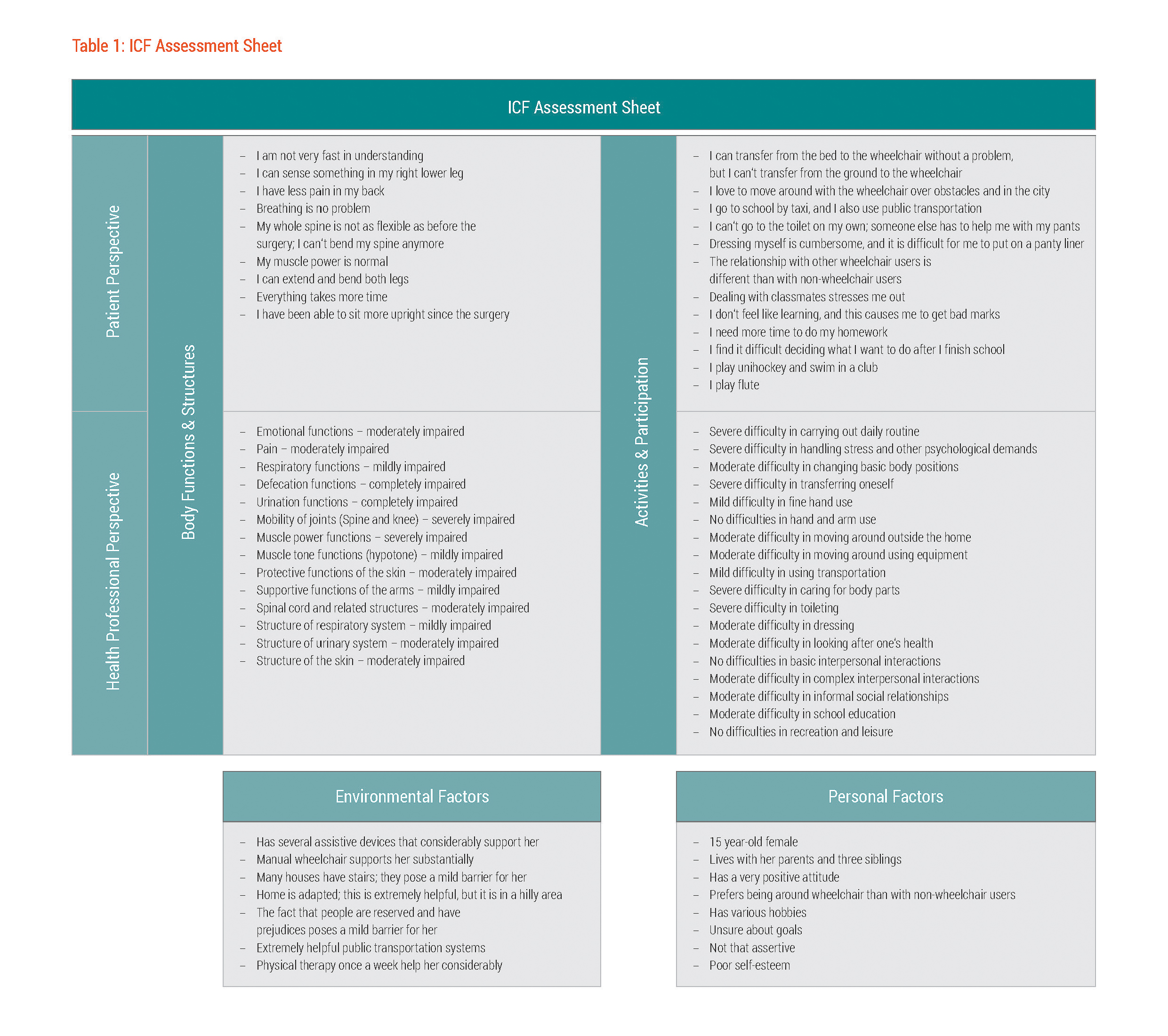Assessment

The Assessment Phase of the Rehab-Cycle®
The assessment of Gabi's functioning included an interview with Gabi as well as tests and examinations performed by individual rehabilitation team members. The results were documented in the ICF Assessment Sheet, a comprehensive overview of Gabi's functioning status presented according to the International Classification of Functioning, Disability and Health (ICF) components of body functions and structures, activities and participation, and environmental and personal factors.{cs13-fn15} Some of Gabi's statements during the interview were also included in the ICF Assessment Sheet. Having this overview helped Gabi and the rehabilitation team to identify her needs, and to support the planning of interventions for the Rehab-Cycle®. See table 1.

Table 1: ICF Assessment Sheet
Gabi expressed her wish to decrease her dependence on her family. She required much assistance in executing daily activities, particularly in dressing. Problems with dressing further resulted in complete dependence on others when toileting, since she was unable to put on her pants by herself after using the toilet. This, in turn, meant that she was unable to be left alone for any extended period of time.
She also experienced limitations in mobility due to her stiffened spine. Despite Gabi's view that her muscle power was normal (considering that she had never experienced it otherwise), her mobility with the wheelchair was limited as a result of the spinal fixation and the relatively short length of her arms. Additionally, she was unable to dock and undock the wheelchair-handbike independently and required constant assistance in transferring from the ground to the wheelchair. In sum, Gabi felt mobility and self-care were critical factors for gaining independence. As an essential part of the efforts toward independence, Gabi's emotional (in)stability also had to be addressed.
""Gabi felt mobility and self-care were critical factors for gaining independence.""
Gabi’s experience of limitations in activities was not only related to movement, but also to mental acuity. She felt that she was “slow in understanding,” normally needing more time than others to complete her homework – a fact that further reinforced the idea that she was “different” from her other classmates. In fact, her perceived learning difficulties were confirmed by poor grades.
Related to school was also the aspect of social participation and peer relationships. Gabi expressed a number of her concerns regarding her relationship with non-wheelchair using classmates, or “walkers” as she called them. She found her interactions with walkers to be stressful. She was subject to regular teasing, and was often excluded from activities. Gabi recognised that there was a real and qualitative difference between her relationship with walkers and with wheelchair-using peers. The difference was dramatic – with wheelchair-using peers, Gabi was more open and was able to communicate better. She also enjoyed their company.
""Gabi recognised that there was a real and qualitative difference between her relationship with walkers and with wheelchair-using peers.""
However, it was not just peer relationships that caused Gabi stress in school. She was beginning to have concerns about her future i.e. about possible vocational training. At the time of assessment, Gabi was soon to start her final year of school.
Gabi's assessment of the problems in functioning was supported by the rehabilitation team. From their point of view, the three main areas to be addressed during rehabilitation were mobility, self-care and peer relationships.
Factors such as pain, limited joint mobility, problems in changing body positions, transferring, moving around outside of the home, use of the wheelchair, and transportation all reduced Gabi's mobility. The factors that decreased Gabi's ability to perform adequate self-care were urinary system dysfunction, difficulties in carrying out a daily routine, changing her body position, transferring herself, caring for body parts, toileting, dressing, and looking after her own health. Finally, the rehabilitation team felt that peer relationships were closely related to her emotional functions, and that these influenced each other.
Accordingly, Gabi indicated limitations in interpersonal interactions and informal social relationships, primarily with persons without disabilities. Also relevant to her social functioning, Gabi was thought to have low assertiveness and low self-esteem, both of which tended to further restrict her participation at school.
With the completion of the ICF Assessment Sheet, the first step in the assessment phase of the Rehab-Cycle® was also completed. The next step in the assessment phase was to consider this “laundry list” of needs, limitations, environmental and personal factors, and set long- and short-term goals as well as define the intervention targets that Gabi and her rehabilitation team needed to address during the intervention phase.